Table of Contents
Phone Banking, and more recently, text messages, have cemented their positions in the political campaign arsenal, making political advocacy calling texting key tools for reaching and mobilizing voters.
As with all things, there are ways you can optimize your results using these tools.
You can read on to find out how to use calling, messaging, and a combination of both to run effective political outreach campaigns.
Building your contact list
You may already have a list from your local election office, your political party, or from data vendors like L2 or Aristotle. That’s good. But those lists need work before you can run targeted campaigns with them.
In order to build a list of contacts from people who explicitly support your campaign and of people who are new to the political process, you need to have a way to collect their data.
Building a supporter list with SMS Opt-ins
Giving supporters the chance to opt in through sms messages means you are making it more convenient for them to voice their support.
Here’s an example of how Bernie Sanders collects information from supporters via SMS sign up:
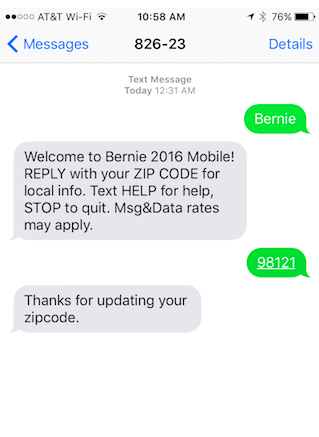
Right after getting an opt-in from a supporter, an automated message is sent out asking for their ZIP code, so that follow up messages can be more personalized.
Other information you could ask for include your supporters’ names and email IDs.
Learn about Text-to-Join campaigns on CallHub.
Once you have set up your SMS Opt-in campaign, promote it across your communication channels, including social media platforms, newsletter, and events.
Carrying out Voter ID
In order to carry out more targeted communication with supporters, you need to run a Voter ID campaign. By identifying likely supporters, you create your campaigns GOTV universe, the list of contacts you target to get them out to vote on election day.
Depending on how and where you are getting your contact lists, you may be missing crucial information, such as party affiliation, email address, history of voting or voter stance on specific issues. A voter ID campaign can solve those problems.
Voter ID efforts are often carried out through door-to-door canvassing and phone banking.
Phone banking for Voter ID
For example, you can call people to determine which voters will probably vote for your campaign and separate them from those who need to be persuaded to vote for you, letting you target the former category with a GOTV campaign. In addition to calls from a mobile phone, you can also send messages through SMS or voice broadcasts to reinforce your campaign message and follow up with identified supporters.
A way for volunteers to identify the support level of volunteers is to rate them on a scale based on the conversation, e.g. 1-5 where 1 is highly likely to vote and 5 is highly unlikely. These supporter levels can be noted as survey responses by agents in CallHub.

The importance of voter ID campaigns increases with the number of people you have on your list. With a ton of people, it’s important to identify your supporters, to avoid wasting time trying to get nonsupporters out to vote for your candidate.
Learn how to set up a phone bank with CallHub
Sending a text during or after a call
For those voters who are unsure about who to vote for and would like to know more about your candidate, send them a quick SMS during or after your call. The message can have a link to a webpage listing your candidate’s top issues.

If talking to contacts over a landline, your volunteers can collect their mobile number and opt-in right in the calling interface, and shoot out a text.
If your contacts don’t pick up, your volunteers can send a text letting them know why they were called, increasing the chance of them picking up on the next attempt.

All you need to do to start sending texts from your calling campaign is to enable the option when setting up your campaign.
SMS Opt-in for Voter ID
As mentioned before, you can join via text to collect additional data on your supporters right after they text into your number.
Learn how to set up an SMS Opt-in campaign with CallHub
Sending peer-to-peer text messages
Peer-to-peer texting is a great way to have conversations with supporters throughout a campaign for politics.
Take, for example, the Dianne Watts BC Liberal Party leadership campaign. They saw a 20% response rate from their one-to-one peer texting, 4.8% of whom were previously unidentified supporters.
Learn how to start sending peer-to-peer texts with CallHub
Volunteer recruitment and management
The best time to convert your supporters into volunteers is when you are running your voter ID campaign.
Phone calls for volunteer recruitment
Once you identify supporters, ask them if they are willing to spend their time to help your campaign.
In the case of Les Republicains, one of the two major political parties in France, the party recruited 800 volunteers in 4 months and made 900,000 calls to their supporters.
This was done with the help of a script in CallHub, telling volunteers exactly what to say every phone call. After the call, the volunteers were able to enter notes about the calls. These notes were recorded in the campaign database immediately.
Learn how to set up a phone bank with CallHub
Text messages to manage your volunteers
Once you have volunteers recruited and ready to help, you need to keep them updated. At this stage, using SMS to communicate with volunteers offers easy visibility and allows quick back and forth between volunteers and field organizers.
An organizer can manage multiple volunteers at once with one-to-one peer texting. It allows organizers to have personalized conversations with each of their volunteers, and keep track of all of them from a single interface. You can also compliment these messages with updates on social media to boost engagement and motivation among volunteers.
Learn how to start sending P2P texts in CallHub
GOTV Campaigns
Once you have your GOTV universe, reach out to them as election day draws nearer.
Irrespective of how many volunteers you have, it can be very daunting to reach every supporter on your GOTV list by manually dialing their numbers. CallHub significantly speeds up that process.
Audio calls for GOTV
Audio calls have been shown to produce a marked improvement to voter turnout in multiple studies.
Jagmeet Singh, who ran for the leadership of the NDP in Canada used phone banking extensively for his GOTV efforts. With an impressive turnout of 70% among segments of Jagmeet’s supporters, he went on to win the election, becoming the youngest leader in the party’s history.

In Canada, Organizing for Change, an environmental coalition group used phone banking to drive calls to British Columbia voters to get them out to vote in their recent provincial elections, increasing voter turnout by 7%.
Learn how to set up a phone banking campaign in CallHub
Sending a text message during or after a call
After a call, agents can send voters their polling location as well as directions to reach it.

Again, if you only have the landline number for a contact, your volunteer can save their mobile number in the calling interface and shoot them a text.
Learn more about sending texts from within call center campaigns
P2P text messages for GOTV
With P2P texting, volunteers can engage potential voters in personal conversations, and encourage them to vote. Because of its conversational nature, P2P texting gives your agents the ability to answer queries and send follow-up texts.
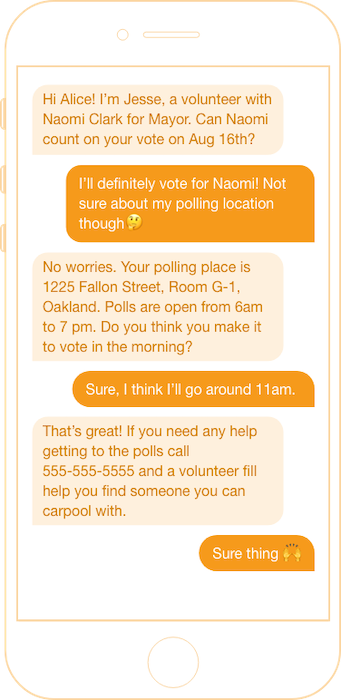
Use P2P texting to help voters make a plan to go out and vote on election day.
Learn how to start sending P2P texts in CallHub
Broadcast text messages for GOTV
A broadcast text goes out to every voter on your list at once. That means you don’t need the help of volunteers. It also means you’re sending a one-off text and not having engaging conversations with voters.
Use broadcast texts to send out quick, informational texts to voters ahead of election day. For example, informing voters in a locality about their polling station address.
Learn how to set up a Broadcast text campaign in CallHub
Making fundraising asks to supporters
Effective fundraising can mean the difference between success and failure in an election. Reach out to supporters at appropriate intervals to ask for a donation.
Like GOTV campaigns, these calls and messages should go out to those contacts who have been identified as supporters of your campaign.
Telephone calls for fundraising
Social media is great for getting your fundraising campaign out and in front of supporters on a large scale. But, nothing is quite as effective as having live conversations with supporters to ask for a contribution.
Follow up text after a fundraising call
An effective follow-up is a key part of any fundraising campaign. High value asks, like making a donation require meeting donors at multiple touchpoints. One of those touchpoints is right after you call them.
Send willing donors a confirmation text message, with a link to your mobile donation page

Learn more about sending texts from within call center campaigns
P2P texts for fundraising
P2P texting is a convenient way to reach donors. With texting, your volunteers can make appealing asks and then send donors all the information they need to make a contribution in a single, engaging conversation.
Learn how to start sending P2P texts in CallHub
Send updates with broadcast texts
Donors appreciate being kept up to speed on your fundraising efforts. Send messages that show the impact they made on your campaign to help them see the difference they contributed to.
You can even shoot out a text message to supporters at key moments of the campaign. For example, after a town hall or a debate, and ask for a donation.
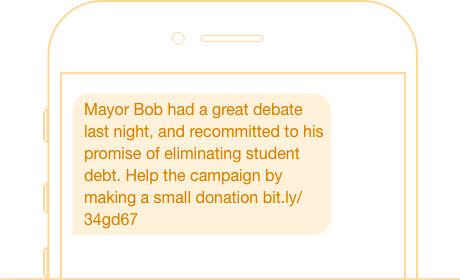
Learn how to set up a Broadcast text campaign in CallHub
Running polls
By running opinion polls, you understand the pulse of your supporters/voter group.
It informs your campaign how voters feel about your stance on important issues, whether they relate to your policy and your campaign messaging.
Political phone surveys
Run quantitative tests through opinion polls to find the hard numbers on how your messaging is doing.
One way to do that is through political phone surveys.
Phone surveys involve a live interviewer asking questions around an issue and marking responses on a 5-7 point scale (Strongly Disagree, Moderately Disagree, Slightly Disagree, Slightly Agree, Moderately Agree, Strongly Agree).
Learn how to set up a political phone survey with CallHub
Using texts to run opinion polls
Send out a mass texting campaign to subscribers asking them for their opinion on an issue or an event.
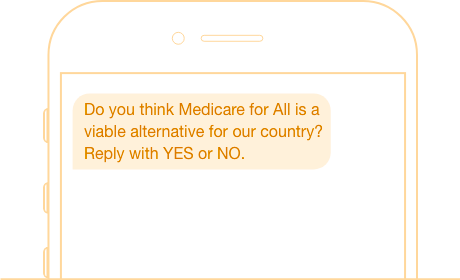
In CallHub, the responses are stored so you can analyze them later.
Sending campaign updates to supporters
Keep supporters informed about your candidate’s schedule and other campaign updates.
Campaign updates through broadcast text messages
A quick broadcast text is an easy way to reach all your supporters quickly and efficiently, especially if you send out time-sensitive info. Make sure to consider the recipient’s time zone when sending such messages to ensure higher open rates and engagements.
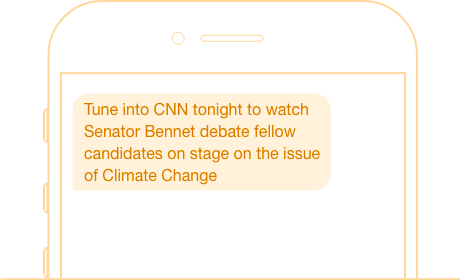
Ready to make the most of your calling campaigns with text messages? Try it out today.
If you don’t have an account with CallHub yet, you can get one here.

